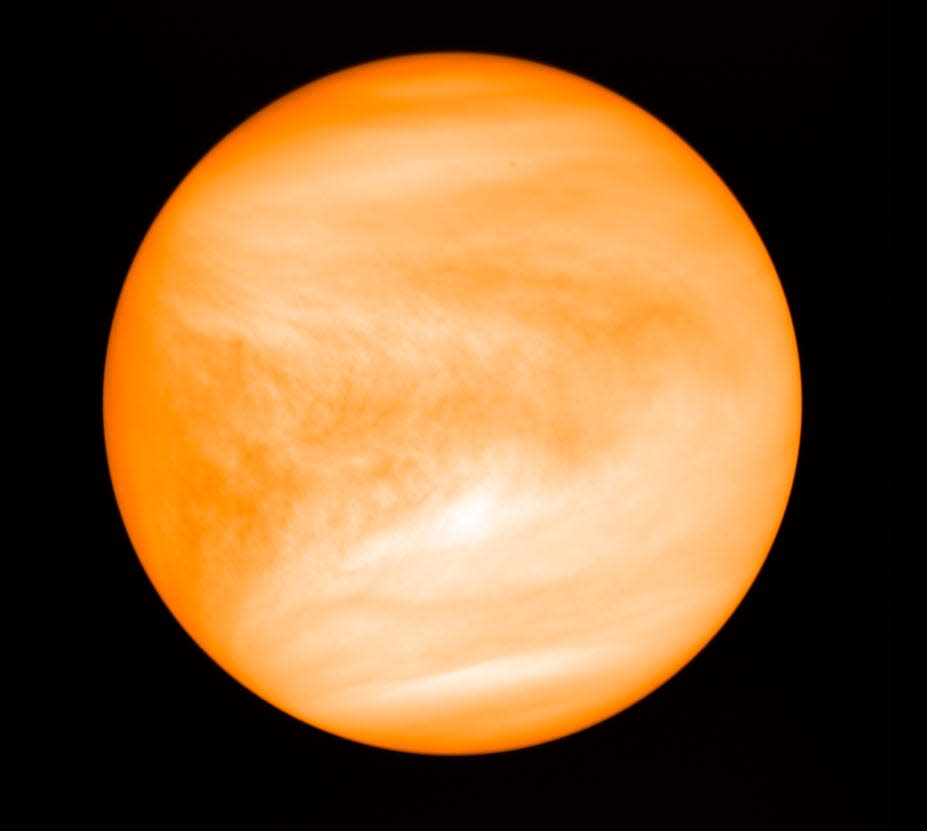Stunning facts about Venus, Earth's 'sister planet,' where every day is 900 degrees
Venus was the goddess of beauty in ancient Rome and her brightly shining planetary namesake lives up to that hype. When Venus is in the evening sky, you notice her. When she is in the predawn sky, you can’t miss her. When Venus shines, she looks like a heavenly visitor.
Venus is the planet that can come closest to Earth and is most similar in size to our planet. In fact, Venus is often called our “sister planet.” But upon closer examination, Venus is full of many alien extremes that make her one twisted sister.
Do this: How to escape city light pollution and see the stars like never before
Extreme heat and pressure
Venus has an incredibly thick carbon dioxide atmosphere. This blanket of clouds makes the weather on Venus inhospitable to life but extremely stable. Every day is cloudy and 900 degrees Fahrenheit. Daytime, nighttime, on the equator or at the poles, it is always 900 degrees and cloudy. These clouds dominate the weather on Venus by trapping the sun’s energy and distributing it over the entire Venusian surface. Of course, a visitor would need to watch out for the occasional rain shower. When the clouds open up, they do not rain water. They rain sulfuric acid.
The Venusian atmosphere not only traps in heat but is also extremely heavy. On Earth, the atmosphere pushes down on you very comfortably. But on Venus, the atmospheric pressure is about 93 times that of Earth. It would exert such a force on you that your body would crumple under the weight.

Shrouded in mystery
Since Venus is covered in clouds, astronomers had no idea what the planet looked like until about 30 years ago. In 1990 NASA’s unmanned Magellan spacecraft became the first mission to orbit the planet Venus. It hitched a ride into Earth orbit in the payload bay of the Space Shuttle Atlantis in 1989. Astronauts released it into space where it rocketed away from Earth and took a roundabout 15-month journey to Venus.
From 1990-1994, Magellan used radar to peer beneath the thick clouds and map the surface of Venus. Over the course of thousands of orbits, Magellan imaged 98% of the surface and delivered the first high-resolution maps of our sister planet.

Where a day is longer than a year
Venus is tilted in a way completely different from any of the other seven planets. The planet appears to be upside-down and spins backward. If the Earth spun in the same direction as Venus, the sun would rise in the west and set in the east.
But Venus rotates (backward) so slowly that a day on this planet is longer than its year. While the Earth completes one spin each day, Venus rotates so slowly that it takes 243 Earth days to rotate one time. Meanwhile, Venus is closer to the Sun than we are, so its year (the time it takes to orbit the sun once) is only 225 days. Venus is the only planet in the solar system with a situation like this.
Venus, the evening star
Venus can best be seen just before sunrise or just after sunset, depending on where it is in its orbit. Some people call Venus the morning star or evening star, depending on the timing of its appearance. Venus looks especially good when it is near a waxing crescent Moon in the fading twilight of evening, or when it cozies up to a waning crescent moon just before dawn.

For the next several months, you can’t miss seeing Venus blaze in the western sky after sunset. She will hang in the twilight sky every evening until July. In fact, mark your calendars for Venus shining next to the crescent moon on June 21 and sharing the sky with the moon and Mercury on July 19 and 20.
Dean Regas is the astronomer for the Cincinnati Observatory and author of the books "1,000 Facts About Space" and "How to Teach Grown-Ups About Pluto." For a daily Space Fact, follow him on Instagram, @deanregas.
Event: Venus Night at the Cincinnati Observatory
What: Venus Night includes programs about our hottest planetary neighbor and self-guided tours of the observatory and grounds. Then, see the clouded, shrouded goddess of beauty for yourself through our historic telescopes along with the moon and stars (weather permitting).
When: May 27, 8:30-10:30 p.m.
Where: Cincinnati Observatory, 3489 Observatory Place.
Tickets: $15/adult, $10/child.
Information: cincinnatiobservatory.org.
This article originally appeared on Cincinnati Enquirer: Facts about Earth's 'sister planet' Venus, goddess of the evening sky

